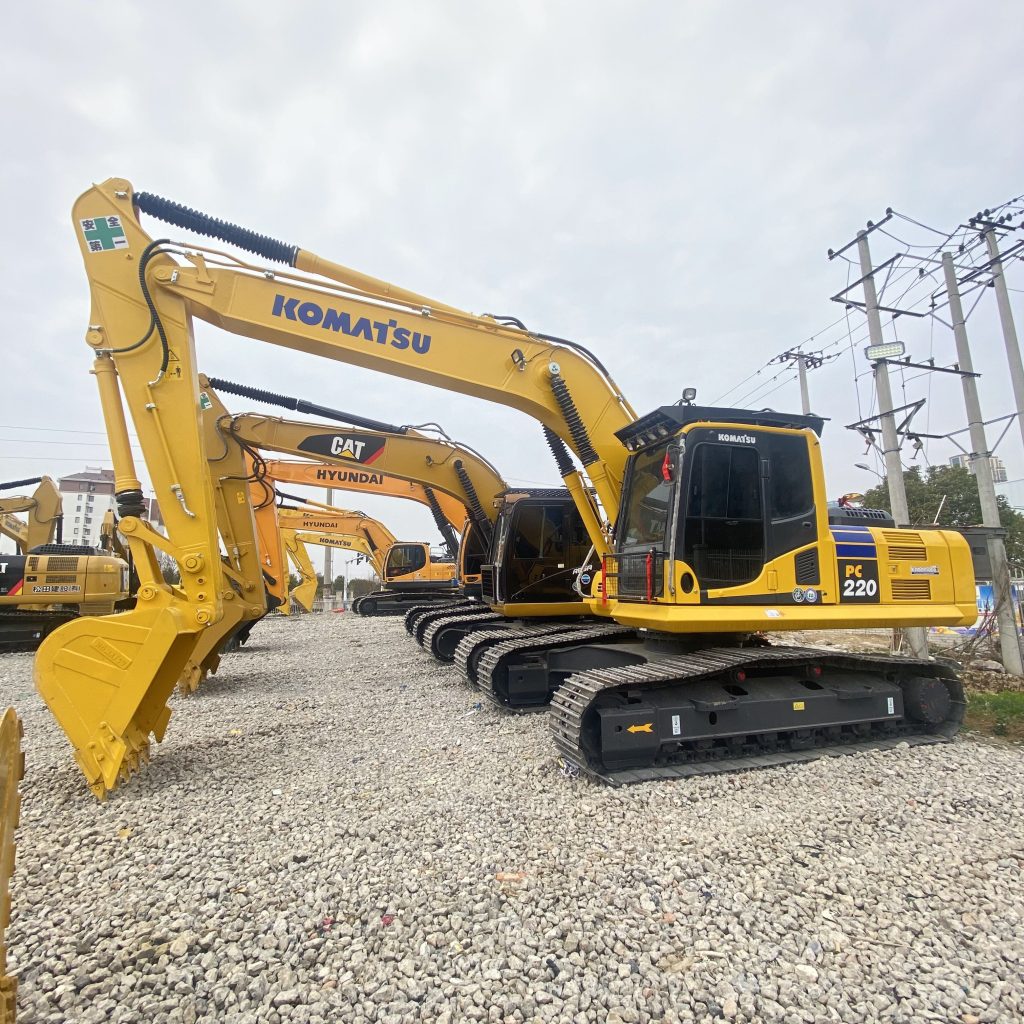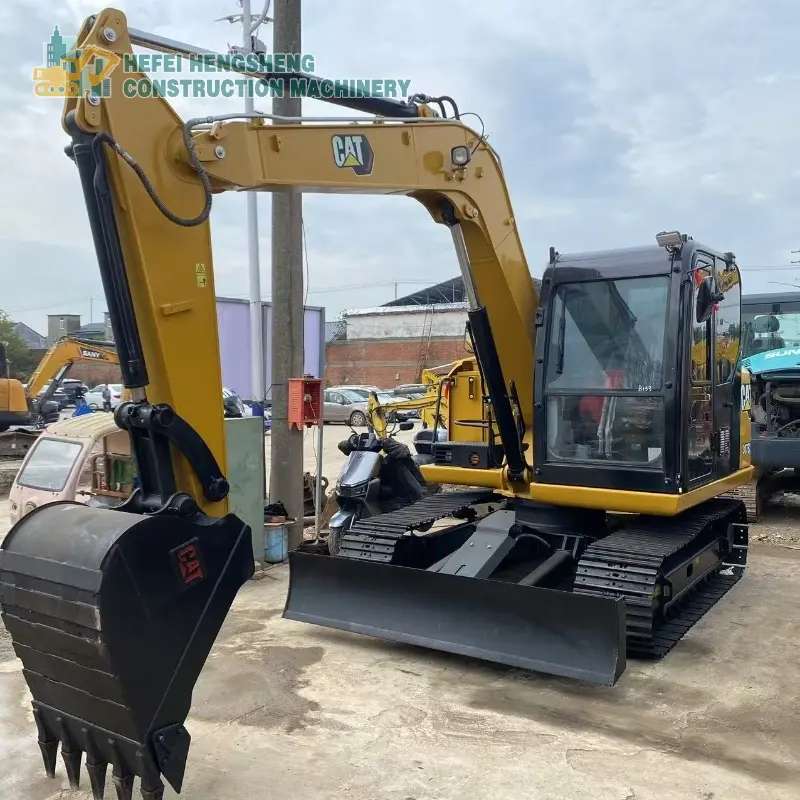كيف تزيد قيمة حفارة مستعملة بعد شرائها؟ دليل الصيانة والتحسين
وقت الإصدار: 2025-06-13
بعد شراء حفارة مستعملة، يُعدّ تعظيم قيمتها من خلال ضمان تشغيلها المستقر طويل الأمد وأدائها الفعال أمرًا بالغ الأهمية. إليك بعض إرشادات الصيانة والتحسين:
1. التفتيش والتقييم التفصيلي
بعد شراء حفارة مستعملةالخطوة الأولى هي إجراء فحص شامل لتقييم حالته التشغيلية الحالية. تشمل مجالات التركيز ما يلي:
حالة المحرك: تحقق من أداء المحرك بحثًا عن أي أصوات غير عادية أو اهتزازات أو تسربات زيت.
النظام الهيدروليكي: فحص جودة الزيت الهيدروليكي، والتأكد من أن المضخة الهيدروليكية والصمامات تعمل بشكل صحيح، والتحقق من وجود تسربات.
نظام المسار والسفر: التحقق من التآكل على المسارات والتحقق مما إذا كانت آليات قيادة نظام السفر تعمل بسلاسة.
النظام الكهربائي: فحص البطارية والدوائر والمستشعرات والمكونات الأخرى للتأكد من التشغيل العادي.
الأجزاء الهيكلية: فحص الهيكل الرئيسي، وخاصة الدلو، والذراع، وأجزاء التأرجح، والهيكل بحثًا عن الشقوق، أو التشوه، أو التآكل المفرط.

2. الصيانة الدورية واستبدال المواد الاستهلاكية
استبدال الزيت والفلتر: غيّر زيت المحرك وزيت الهيدروليك بانتظام. استبدل الفلاتر (مثل فلتر الزيت، وفلاتر الهواء، وفلاتر الهيدروليك) حسب الاستخدام لضمان نظافة المحرك والنظام الهيدروليكي وإطالة عمرهما.
صيانة نظام التبريد: تحقق من مستويات سائل التبريد ونظف الرادياتير للتأكد من أن المحرك يعمل ضمن نطاق درجة الحرارة المناسبة لمنع ارتفاع درجة الحرارة.
نظام زيت الهيدروليك: افحص مستوى زيت الهيدروليك وجودته وضغطه بانتظام. غيّر ونظّف النظام عند الحاجة لمنع التلوث.
صيانة البطارية: حافظ على نظافة البطارية، وتحقق من وجود تآكل على أطراف البطارية، وتأكد من الشحن المناسب لتجنب صعوبات بدء التشغيل.
3. نصائح التشغيل والاستخدام
تجنب التحميل الزائد: أثناء التشغيل، تجنب دفع حفارة 90% جديدة ومستعملة يتجاوز سعته التصميمية. تحكّم في حمل العمل لضمان عمل الآلة ضمن سعتها المقدرة، مما يُقلّل من تآكل المحرك والنظام الهيدروليكي.
التشغيل السليم: تجنب التشغيل العنيف، مثل التشغيل والتوقف المفاجئ. شغّل الآلة بسلاسة وحذر لتقليل التآكل الميكانيكي وتحسين الكفاءة.
التنظيف المنتظم: بعد كل استخدام، قم بتنظيف الجزء الخارجي للحفارة، وخاصة المسارات والدلو، لمنع تراكم الأوساخ أو الطين أو الحطام الذي قد يؤثر على الأداء.
4. تعزيز الكفاءة والأداء
قم بتثبيت ملحقات فعالة: فكر في إضافة ملحقات عالية الكفاءة، مثل الدلاء الأكثر متانة أو الكسارات الهيدروليكية المحسنة، لتعزيز قدرة الحفارة على العمل وتعدد استخداماتها.
ترقيات البرامج: بالنسبة للآلات ذات أنظمة التحكم الإلكترونية، قم بترقية أو معايرة البرنامج بشكل دوري لتحسين الأداء وإطالة عمر الخدمة وتقليل احتمالية حدوث أعطال.
التحسين الميكانيكي: ضبط معلمات التشغيل مثل التدفق الهيدروليكي والضغط وما إلى ذلك، استنادًا إلى ظروف العمل الفعلية لتحسين وضع عمل الحفارة لتحقيق كفاءة أعلى.
5. التخزين والحماية
بيئة التخزين: عندما لا تكون الماكينة قيد الاستخدام، قم بتخزين الحفارة في منطقة جافة ومظللة لمنع تعرضها للمطر أو العناصر المسببة للتآكل.
الحماية من التآكل: بالنسبة للآلات التي تظل خاملة لفترات طويلة، قم بتطبيق معالجات مضادة للتآكل، مثل طلاء الأجزاء المعدنية بزيت مقاوم للصدأ، لحماية المكونات الخارجية والداخلية من التآكل.
6. عمليات التفتيش الدورية والخدمة المهنية
عمليات التفتيش المنتظمة: حتى لو حفارة مستعملة بحالة جيدة يبدو جيدًا، ومن الضروري إجراء فحوصات تفصيلية دورية لتحديد المشكلات المحتملة.
الدعم المهني: إذا كان ذلك ممكنًا، قم بتعيين فنيين محترفين لإجراء عمليات تفتيش وتعديلات شاملة للحفاظ على المعدات في حالة مثالية.
7. الحفاظ على سجل الصيانة
سجل الصيانة: احتفظ بسجلات مفصلة لكل عملية صيانة وإصلاح واستبدال قطع غيار. هذا يُنشئ نظامًا لسجل الصيانة، مما يُساعد على تتبع استخدام الجهاز، ويضيف قيمة للمشترين المحتملين.
بإجراء فحوصات دقيقة، وصيانة دورية، وتشغيل واستخدام سليمين، وتحسين الأداء في الوقت المناسب، وضمان التخزين المناسب، يُمكنك إطالة عمر حفارة مستعملة بشكل ملحوظ، وتحسين كفاءتها، وزيادة قيمتها عند إعادة بيعها. فالصيانة الدورية لا تُقلل من احتمالية الأعطال فحسب، بل تضمن أيضًا أداءً مثاليًا للآلة في مختلف ظروف العمل، مما يوفر تكاليف إصلاح كبيرة ويعزز قيمتها عند إعادة بيعها.


